SCHOLARSHIPS : University of Milan

Also known as ‘La Statale’, the University of Milan is, relatively speaking, one of Italy’s younger university institutions. It was founded in 1924 thanks to the tenacious efforts of doctor and gynaecologist Luigi Mangiagalli, who in creating La Statale, realised his long-held dream of building a university for Lombardy’s regional capital.
Indeed, up until that point, it was the University of Pavia, founded in the fourteenth century and the main education centre in northern Italy, that housed the traditional university faculties. Over the centuries, however, the numerous educational institutions and schools of excellence which sprang up in Milan would later be incorporated under the University of Milan.
These included the Accademia Scientifico-Letteraria (Academy of Letters and Science) founded in the nineteenth century, which laid the foundations for the Faculty of Humanities; the Scuole Palatine (Palatine Schools), established at the start of the seventeenth century, which numbered intellectuals and scholars such as Paolo Frisi, Cesare Beccaria and Giuseppe Parini among its teachers; the Scuole superiori di Veterinaria e di Agraria (Schools of Advanced Studies in Veterinary Medicine and Agriculture); the Osservatorio astronomico di Brera (Brera Astronomical Observatory) and - another of Luigi Mangiagalli’s visions - the Istituti Clinici di Perfezionamento (Clinical Specialisation Institutes) established in 1906, for the training of young doctors.
A representative of the Chamber of Deputies in 1902 and later mayor of Milan, Mangiagalli, together with a group of Milanese members of the Association for the Promotion of High Culture, set about creating the city’s very first university. The project finally became a reality when in 1913, the City Council of Milan granted them some land on the eastern fringes of the city, an area that Mangiagalli himself had earmarked as a “Città degli Studi” (“City of Studies”), a name still used today to refer not only to the University but to the entire district in which it is located. Building work began in 1915 and was completed more than a decade later.
The founding of the University of Milan in 1924 came about with the institution of the first four faculties: Law, Humanities, Medicine and Mathematical, Physical and Natural Sciences. The event was officially celebrated on 8 December of the same year with a ceremony at Castello Sforzesco (Sforza Castle).
The early years in the history of the University, of which Mangiagalli was Rector until 1926, were followed by a period of continuous growth up until World War Two: the number of students reached 3,000 and the number of faculties increased to six (the Faculties of Agriculture and Veterinary Medicine having been added in the ‘30s), located in Città Studi, home to the scientific faculties, and in the historic city centre.
Another key step forward came with the reform of the university system which introduced the distinction between the Laurea triennale (Bachelor's degree) and the Laurea magistrale (Master's degree). Since the reform was first applied by the University in the 2001-2002 academic year, the number of degree courses on offer has increased from 47 to 74. In 2006-2007, the number of students enrolled in the University surpassed 62,000, with a further 7000 students enrolled on postgraduate programmes.
A multidisciplinary, innovative educational offering and a continuous focus on the new professional skills demanded by a rapidly evolving labour market have characterised the University since its early days. Over the years the University has also strengthened its commitment to technology transfer and to the practical application of scientific research results in the economic-production context.
In recent years, this commitment has taken on the form of a project to create a science Campus within the new Milan Innovation District (MInD), the site of Expo 2015, now set to become the home of a prestigious centre for science and technology. Approval of the project by the academic bodies in 2015-2016 paved the way for transferring the science faculties to the future Campus; further support is provided by another project that aims to redevelop the Città Studi buildings and area.
